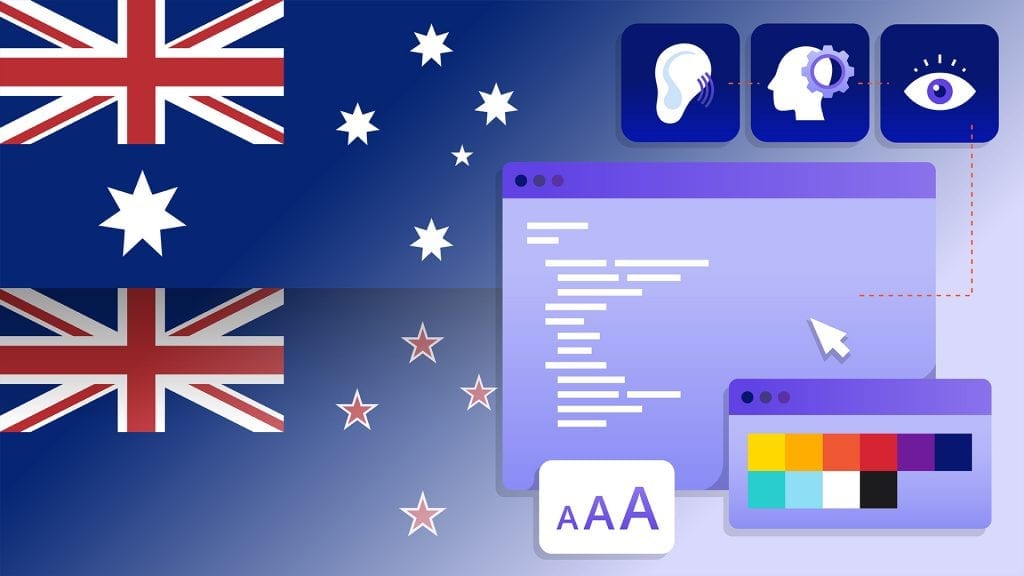Web Accessibility Laws in Australia & New Zealand
What’s required to meet accessibility standards in Australia and New Zealand? Here’s everything you need to know to avoid accessibility violations.

What’s required to meet accessibility standards in Australia and New Zealand? Here’s everything you need to know to avoid accessibility violations.
What Are Web Accessibility Laws?
Australia’s Disability Discrimination Act of 1992 requires equal access for people with disabilities. Australian companies that have websites or companies that maintain resources that are publicly accessible from Australian servers can be impacted. Section 5 of the Act classifies discrimination as treating people with disabilities less favorably than those without disabilities.
If a website is inaccessible to those with disabilities, the business could be required to redesign the website and incur monetary damages.
The National Transition Strategy (NTS) required all government websites to implement the Web Accessibility Initiative (WAI) published by the World Wide Web Consortium (W3C). These guidelines, called the Web Content Accessibility Guidelines (WCAG), provide web content accessibility guidelines.
It’s a similar situation in New Zealand. The New Zealand Bill of Rights Act 1990 and the Human Rights Act 1993 apply to government websites. For businesses and other organizations, the New Zealand Government Web Accessibility Standard applies. Each of these uses the WCAG as a base level for compliance. In other words, complying with WCAG guidelines will fulfill obligations.
Who Does Web Accessibility Law Benefit?
Nearly 20 percent of Australians have a disability. That’s more than 4.4 million people! The number is growing as the population ages. For New Zealand, more than 1.1 million people live with disabilities. That’s roughly 25 percent of adults.
The laws specific people with disabilities as those with:
- Total or partial loss of the person’s bodily or mental functions
- Total or partial loss of a part of the body
- The presence in the body of organisms causing disease or illness
- The malfunction, malformation, or disfigurement of a part of the person’s body
- A disorder or malfunction that results in the person learning differently from a person without the disorder or malfunction
- A disorder, illness or disease that affects a person’s thought processes, perception of reality, emotions or judgment, or that results in disturbed behaviour.
Who Is Required to Follow Web Accessibility Laws?
In both Australia and New Zealand, government agencies and organizations that are public-facing are required to follow web accessibility laws and meet the WCAG web usability standard to provide equal access to information
In addition to these laws, the United Nations’ Convention on the Rights of Persons with Disabilities (UNCRPD) also comes into play. Article 21 governs the right to freedom of expression and opinion by those with disabilities, granting them an equal opportunity with others to participate. The UNCRP has been ratified by both the Australian and New Zealand governments.
How Are Web Accessibility Laws Enforced?
The Australian Human Rights Commission oversees enforcement of the Australia web accessibility standard, although civil suits are possible as well. One of the most notable cases was Bruce Lindsay Maguire v Sydney Organising Committee in advance of the Olympic Games. Maguire is blind and complained that he was illegally discriminated against because, in part, the website was inaccessible. The Commission found that Maguire had been treated less favorably on the basis of his disability. The Organising Committee was forced to make changes to add accommodations.
In another case, Gisele Mesnage, who is blind, sued supermarket giant Coles for being unable to use its website for online delivery after a website upgrade. The case was settled, and changes were also made to the company’s website along with a reported financial settlement.
Globally, the number of complaints and lawsuits have risen. In the United States, for example, that number of class action suits filed last year grew by more than 180% from the previous year.
How to Comply with Australian and New Zealand Web Accessibility Standards
Australia web accessibility standards and NZ web accessibility standards both conform to the Web Content Accessibility Guidelines (WCAG), Organisations that adopt these guidelines will be in compliance.
Remember that section 1.2.2 of the WCAG guidelines requires synchronized captions for all audio and video, which you can get from Rev.com
The WCAG provides a list of recommendations to make online content more accessible to those with disabilities. It covers four main areas for websites:
Perceivable
All users, including those with impaired vision, should be able to see and read your website.
Operable
Websites should be responsive and easy to navigate for all users across multiple browsers and mobile devices
Understandable
Websites should be organized in a way that’s easy to use and use language that most customers can understand.
Robust
Websites should integrate with tools (Assistive Technology or AT) that are used by users with disabilities.
The WAI and WCAG 2.1 Guidelines contain a comprehensive list of items for businesses, User Experience (UX) designers, and web designers. To check whether your website is compliant, here is a list of the online tools available to check for compliance.
Keep reading
Subscribe to The Rev Blog
Sign up to get Rev content delivered straight to your inbox.








